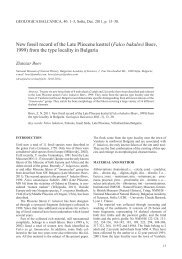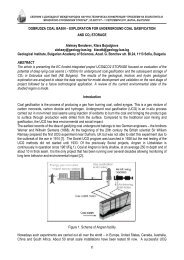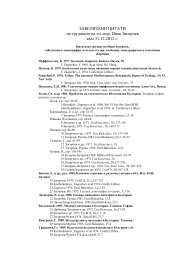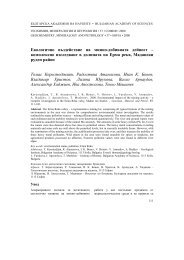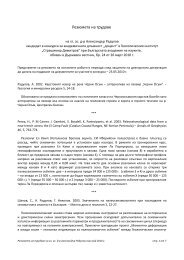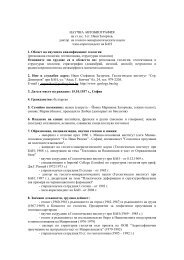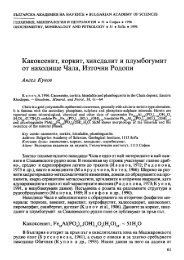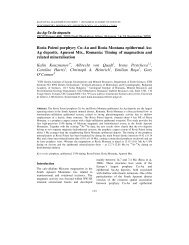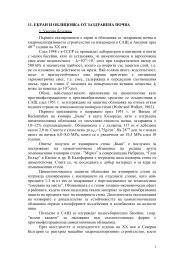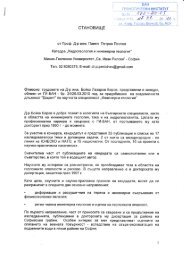2: Hydrothermal ore deposits related to post-orogenic extensional ...
2: Hydrothermal ore deposits related to post-orogenic extensional ...
2: Hydrothermal ore deposits related to post-orogenic extensional ...
Create successful ePaper yourself
Turn your PDF publications into a flip-book with our unique Google optimized e-Paper software.
62<br />
nov, 1972; (Figs. 2, 3, and 5)). Dykes of intraplate<br />
alkaline basalts and lamprophyres are described in the<br />
Biala Reka and Kessebir metamorphic domes (Mavroudchiev,<br />
1964; Marchev et al., 1998b). Their primitive<br />
character along with abundant lherzolite xenolith<br />
fragments and high-pressure pheno- and megacrysts<br />
require derivation from mantle depths.<br />
K–Ar age determination of the igneous rocks in<br />
the Eastern Rhodopes (Table 1) indicate that magmatism<br />
was active between 39 and 25 Ma, with<br />
the younger activity generally prevailing in the<br />
south (Eleftheriadis and Lippolt, 1984; Lilov et<br />
al., 1987; Marchev et al., 1998a; Yanev et al.,<br />
1998b). Precise<br />
40 Ar/ 39 Ar ages demonstrate a<br />
shorter life span in several volcanic centres (e.g.,<br />
V1 Ma at Madjarovo; Marchev and Singer, 2002;<br />
Marchev et al., 2004a). In the Greek part of the<br />
Eastern Rhodopes, an Oligocene igneous complex<br />
with volcanic rocks and coeval grani<strong>to</strong>id intrusions<br />
P. Marchev et al. / Ore Geology Reviews 27 (2005) 53–89<br />
(35 <strong>to</strong> 28 Ma; Del Moro et al., 1988) is overlain<br />
by Lower Miocene volcanism (22 <strong>to</strong> 19.5 Ma;<br />
Pècskay et al., 2003).<br />
3.3. Petrography and elemental and iso<strong>to</strong>pe<br />
geochemistry<br />
The shoshonitic rocks are characterized by plagioclase<br />
rimmed with sanidine (e.g., Mackenzie and<br />
Chappel, 1972), accompanied by water-bearing phenocrysts<br />
(biotiteFhornblende), clinopyroxene and<br />
orthopyroxene. Mafic varieties have olivine or<br />
high-F phlogopite and pheno- or microphenocrystal<br />
apatite. Acid rocks consist of plagioclase, sanidine,<br />
clinopyroxene, biotite Famphibole, accompanied by<br />
quartz in rhyolites. Titanomagnetite is a ubiqui<strong>to</strong>us<br />
phenocryst phase, whereas ilmenite is absent in<br />
the mafic and intermediate rocks and very rare<br />
in the acid varieties. In all shoshonites, the ratio<br />
Fig. 4. K 2O versus SiO 2 plot for Tertiary igneous rocks from the Eastern Rhodope Magmatic Zone. Data from Arikas and Voudouris (1998),<br />
Eleftheriadis (1995), Innocenti et al. (1984), Nedialkov and Pe-Piper (1998); Marchev et al. (1998a, b and unpubl. data). Note the general<br />
decrease of K2O contents from north <strong>to</strong> south, which corresponds <strong>to</strong> the spatial association of the shoshonites with intermediate-sulphidation<br />
mineralization and calc-alkaline and high-K calc-alkaline rocks with high-sulphidation <strong>deposits</strong>. Shoshonites from Petrota graben are the only<br />
exception, but they are older than the calc-alkaline rocks that are believed <strong>to</strong> be associated with mineralization. Field for the rocks associated<br />
with high-sulphidation gold <strong>deposits</strong> from Arribas (1995) is shaded.



